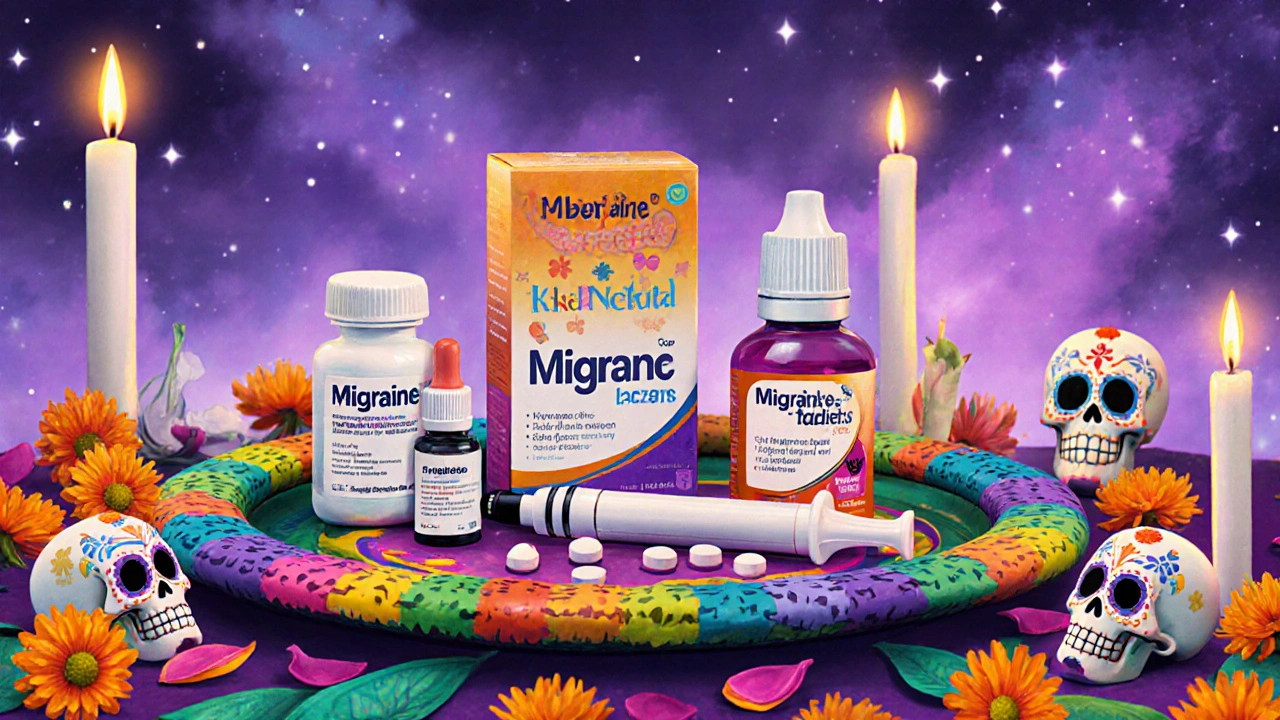Migraine Medication Decision Tool
Key Takeaways
- Maxalt is a fast‑acting triptan that works for many migraine sufferers but isn’t the only option.
- Sumatriptan, Zolmitriptan, Naratriptan and Eletriptan share the same mechanism but differ in speed, duration and side‑effect profile.
- Newer classes such as CGRP antagonists and Lasmiditan provide alternatives for patients who can’t tolerate triptans.
- Choosing the right drug depends on attack frequency, timing of dose, comorbid conditions and insurance coverage.
- Always discuss head‑to‑head comparisons with a pharmacist or physician before switching.
What is Maxalt (Rizatriptan)?
When building a migraine toolkit, Maxalt is a rapid‑acting oral triptan whose active ingredient is rizatriptan. Approved by the FDA in 2001, it’s designed to abort migraine attacks once the pain begins. The tablet dissolves quickly, reaching peak blood levels in 45‑60 minutes, which is why many patients label it the "fast‑acting" option.
How Maxalt Works
Rizatriptan belongs to the triptan class, which targets serotonin (5‑HT1B/1D) receptors around cranial blood vessels. By binding to these receptors, the drug narrows dilated vessels and blocks the release of inflammatory neuropeptides. The result: reduced pain, less nausea, and a quicker return to normal activity.
Benefits and Typical Use
- Onset of relief in under an hour for most users.
- Effective for moderate to severe migraine attacks.
- Available in 5 mg and 10 mg tablets, making dose titration simple.
- Can be combined with an anti‑nausea medication if needed.

Common Side Effects
About 10‑15 % of patients report mild side effects such as:
- Chest tightness or pressure (usually transient).
- Dizziness or light‑headedness.
- Fatigue and dry mouth.
Serious adverse events are rare, but anyone with heart disease should avoid triptans unless cleared by a cardiologist.
Alternative Migraine Medications
While Maxalt works well for many, several alternatives fill the gaps where it falls short.
Sumatriptan
Sumatriptan is the first FDA‑approved triptan, available as tablets, nasal spray, and injection. It’s slower to act orally (30‑60 minutes) but the injectable form provides relief within 10‑15 minutes-useful for severe attacks.
Zolmitriptan
Zolmitriptan is a medium‑duration triptan that offers a quick onset and an oral spray formulation. The spray can be handy for those who dislike swallowing pills during a migraine.
Naratriptan
Naratriptan is a longer‑acting triptan, often chosen for chronic migraine sufferers. Its slower onset (up to 2 hours) can be a downside, but the extended relief helps when attacks linger.
Eletriptan
Eletriptan is one of the most potent triptans, delivering strong pain relief for tough attacks. It carries a slightly higher risk of cardiovascular side effects, so screening is essential.
CGRP Antagonists
CGRP antagonists are a newer drug class that blocks calcitonin gene‑related peptide, a key migraine trigger. Examples include erenumab and galcanezumab, administered via monthly injection. They’re ideal for patients who can’t tolerate any triptan.
Lasmiditan
Lasmiditan is a serotonin 5‑HT1F receptor agonist that avoids vasoconstriction. This makes it safe for those with cardiovascular disease, though it may cause drowsiness.
Aspirin & NSAIDs
Aspirin is a non‑prescription analgesic that can lessen migraine pain when taken early. It’s less effective for severe attacks but can be combined with a triptan for a synergistic effect.
Head‑to‑Head Comparison Table
| Drug | Onset (oral) | Duration of Relief | Typical Dose | Key Contra‑indication |
|---|---|---|---|---|
| Maxalt | 45‑60 min | 4‑6 hrs | 5 mg or 10 mg | Uncontrolled heart disease |
| Sumatriptan (tablet) | 30‑60 min | 4‑8 hrs | 25 mg, may repeat after 2 hrs | Severe CAD |
| Zolmitriptan | 30‑45 min | 3‑5 hrs | 5 mg | Hypertension uncontrolled |
| Naratriptan | 1‑2 hrs | 6‑12 hrs | 2.5 mg | History of stroke |
| Eletriptan | 30‑45 min | 6‑12 hrs | 40 mg | Ischemic heart disease |
| CGRP antagonist (erenumab) | N/A (preventive) | Monthly dosing | 70 mg SC | Pregnancy (no data) |
| Lasmiditan | 1‑2 hrs | 4‑6 hrs | 50‑200 mg | Severe liver disease |

How to Decide Which Medication Fits You
Think of the choice as a short decision tree:
- If you have any heart‑vascular disease, skip all triptans. Consider CGRP antagonists or Lasmiditan.
- If you need rapid relief within an hour, Maxalt, Sumatriptan (tablet) or Zolmitriptan are the front‑runners.
- If you experience frequent attacks (>8 per month), a longer‑acting triptan like Naratriptan or a preventive CGRP blocker may be smarter.
- Check insurance coverage. Some newer drugs have higher out‑of‑pocket costs.
- Trial a single drug for at least two attacks before switching; keep a headache diary to record onset, relief time, and side effects.
Safety, Interactions, and When to Call Your Doctor
All migraine meds can interact with other prescriptions. Triptans, for instance, should not be combined with monoamine oxidase inhibitors (MAOIs) or certain antidepressants (SSRIs/SNRIs) because of serotonin syndrome risk.
Ask your pharmacist about:
- Potential bleed risk when mixing triptans with blood thinners.
- Impact on birth control hormones, especially for women in the "Women's Health" category.
- Whether your over‑the‑counter pain relievers (ibuprofen, naproxen) are safe to pair with a triptan.
If you notice chest pain, severe shortness of breath, or an allergic reaction, seek emergency care immediately-these are rare but serious signals.
Bottom Line
Maxalt remains a solid first‑line option for many migraineurs who need a quick fix, but it’s not a one‑size‑fits‑all. Understanding the nuances of other triptans, the newer CGRP antagonists, and non‑triptan choices lets you personalize treatment and avoid unnecessary side effects. Talk to a pharmacist or your neurologist to test‑drive a couple of options and lock in the best fit for your lifestyle.
How fast does Maxalt work compared to other triptans?
Maxalt typically starts relieving pain in 45‑60 minutes, which is a bit faster than oral Sumatriptan (30‑60 min) and similar to Zolmitriptan. Injectable Sumatriptan can be faster (10‑15 min), but the oral route is most convenient for most users.
Can I take Maxalt with ibuprofen?
Yes, many doctors recommend a combo of a triptan and a non‑steroidal anti‑inflammatory drug (NSAID) like ibuprofen to boost pain relief. Just avoid exceeding the maximum daily dose of ibuprofen and watch for stomach upset.
What if I have high blood pressure?
Uncontrolled hypertension is a red flag for any triptan, including Maxalt. Talk to your doctor about safer alternatives like Lasmiditan or a CGRP antagonist, which don’t cause vessel constriction.
Is Maxalt effective for menstrual migraines?
Many women find Maxalt works well for hormonal migraines because the rapid onset matches the quick escalation of pain. Keep a diary to see if the timing fits your cycle, and consider preventive options if attacks are frequent.
How many Maxalt tablets can I take in a day?
The usual limit is 30 mg per day (either two 10 mg tablets or three 5 mg tablets). Exceeding this increases the risk of cardiovascular side effects.


Dawn Bengel
October 24, 2025 AT 13:36Patriotic US patients deserve the best meds! 🇺🇸
Carla Taylor
October 25, 2025 AT 03:29Hope this helps you find the right migraine fix
Kathryn Rude
October 25, 2025 AT 20:09When you read about Maxalt you notice its quick onset. The drug reaches peak levels in forty‑five to sixty minutes. This speed matters for a migraine that strikes suddenly. Maxalt works by binding serotonin 5‑HT1B‑1D receptors. The same mechanism is shared with other triptans. Yet the tablet dissolves faster than many peers. Patients often feel relief within an hour. Side effects are usually mild and transient. Chest tightness may occur but rarely persists. People with heart disease should avoid it unless cleared. The dosing options of five and ten milligrams aid titration. Combining Maxalt with ibuprofen can improve pain control. Compared to oral sumatriptan it is slightly quicker. Injectable sumatriptan still wins on speed. Newer CGRP blockers provide alternatives for those who cannot tolerate triptans :)
Lindy Hadebe
October 26, 2025 AT 11:49It’s just another pill with the same limitations.
Ekeh Lynda
October 27, 2025 AT 04:29The landscape of migraine therapeutics has expanded dramatically over the past two decades and what was once a narrow set of options now includes multiple triptans CGRP antagonists and even novel serotonin receptor agonists each with distinct pharmacodynamic profiles that require careful patient‑specific consideration the decision matrix involves onset of action duration of relief side effect burden and cost effectiveness which can be overwhelming for both clinicians and sufferers alike the comparative table in the article illustrates these nuances clearly highlighting how Maxalt’s rapid absorption compares with the slightly slower oral sumatriptan and the even faster injectable formulation while also underscoring the importance of cardiovascular contraindications that limit triptan use for many patients the emergence of CGRP monoclonal antibodies offers a preventive strategy that bypasses vasoconstriction but introduces the need for monthly injections and higher out‑of‑pocket expenses ultimately the optimal choice rests on individualized assessment and shared decision‑making between patient and healthcare provider
Dahmir Dennis
October 27, 2025 AT 21:09Oh sure, because taking a drug that can potentially constrict your coronary arteries is exactly what every wise adult wants when they’re already dealing with a pounding headache, right? It’s not like we have any other options that don’t involve a needle or a monthly injection, no, let’s just pop another triptan and hope the chest tightness passes like a bad joke. The sarcasm is palpable when you realize the “fast acting” label is just marketing fluff for a pill that still takes half an hour to kick in while you’re busy hiding in a dark room.
Jacqueline Galvan
October 28, 2025 AT 13:49For patients exploring acute migraine relief, Maxalt offers a convenient oral option with a relatively quick onset, making it suitable for attacks that develop suddenly. It is advisable to start with a 5 mg dose and assess response before considering the 10 mg tablet, especially if you have a history of cardiovascular concerns. Combining Maxalt with an NSAID such as ibuprofen can provide synergistic analgesia, but monitor for gastrointestinal irritation. Always maintain a headache diary to track efficacy, timing of relief, and any adverse effects, and discuss your findings with your neurologist to fine‑tune your treatment plan.
Tammy Watkins
October 29, 2025 AT 06:29Indeed, the strategic incorporation of Maxalt into a comprehensive migraine management protocol necessitates a meticulous evaluation of pharmacokinetic parameters and patient‑specific comorbidities; the clinician must weigh the rapid absorption profile against potential serotonergic interactions, particularly in individuals concurrently prescribed selective serotonin reuptake inhibitors or monoamine oxidase inhibitors, wherein the specter of serotonin syndrome looms ominously. Moreover, the dosage titration schema should be predicated upon empirical data derived from longitudinal diary entries, facilitating an evidence‑based escalation or de‑escalation of therapy. In scenarios where vascular contraindications preclude triptan utilization, the clinician is compelled to pivot toward CGRP monoclonal antibodies or the novel 5‑HT1F agonist Lasmiditan, each embodying distinct mechanistic pathways that circumvent vasoconstriction while presenting their own safety considerations. Thus, a personalized, data‑driven approach remains the cornerstone of optimal acute migraine intervention.
Dason Avery
October 29, 2025 AT 23:09From a philosophical standpoint the quest for relief mirrors the human pursuit of harmony; when the storm of pain descends, a swift ally like Maxalt can restore equilibrium, and that’s something to celebrate 😊 the journey of trial and error becomes a learning experience, guiding us toward the most effective regimen.
HILDA GONZALEZ SARAVIA
October 30, 2025 AT 15:49When comparing Maxalt to other triptans it’s clear that onset time, duration, and side‑effect profile all play pivotal roles in patient preference. The table shows that oral sumatriptan and zolmitriptan have comparable speeds, while naratriptan offers longer relief but slower onset. For those with cardiovascular risks, non‑vasoconstrictive options like Lasmiditan or CGRP antagonists become attractive alternatives. Cost and insurance coverage also heavily influence the final decision. Keeping a detailed log of each migraine episode can help you and your doctor pinpoint the best medication.
Mary Mundane
October 31, 2025 AT 08:29Data speak louder than anecdotes, stick to the numbers.
junior garcia
November 1, 2025 AT 01:09People need quick relief, and Maxalt can be that hero in the dark.
Casey Morris
November 1, 2025 AT 17:49Indeed!!! The rapid absorption of rizatriptan is truly remarkable; it offers patients a swift exit from the throbbing torment!!! However, one must remain vigilant regarding potential cardiovascular contraindications; a thorough screening process is indispensable!!!
Teya Arisa
November 2, 2025 AT 10:29Dear community, I appreciate the shared experiences regarding Maxalt and its alternatives; it is evident that individualized care is paramount 🚀. Should you encounter any uncertainties, please feel comfortable reaching out for guidance, and remember that compassion and diligence are key components of effective migraine management 😊.
Kester Strahan
November 3, 2025 AT 03:09Yo bro, the pharmaco‑kinetics of rizatriptan are legit on point, but u gotta consider the bioavailablity variance when co‑admin w/ NSAIDs – it’s like a synergy effect but also a risk factor, lol. Also, watch out for the CYP450 interactions, especially with SSRIs – can cause a serotonin storm if u ain’t careful.